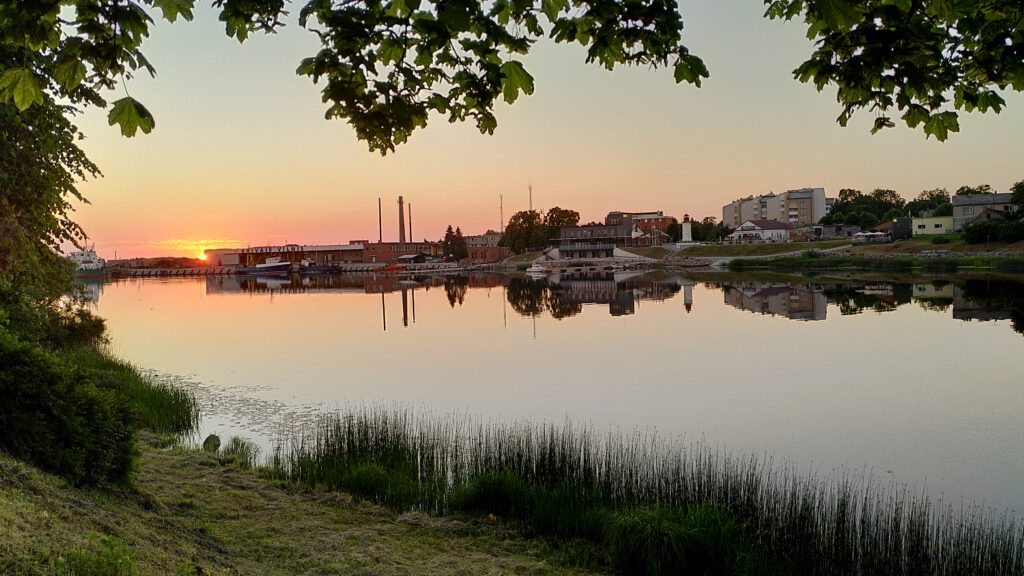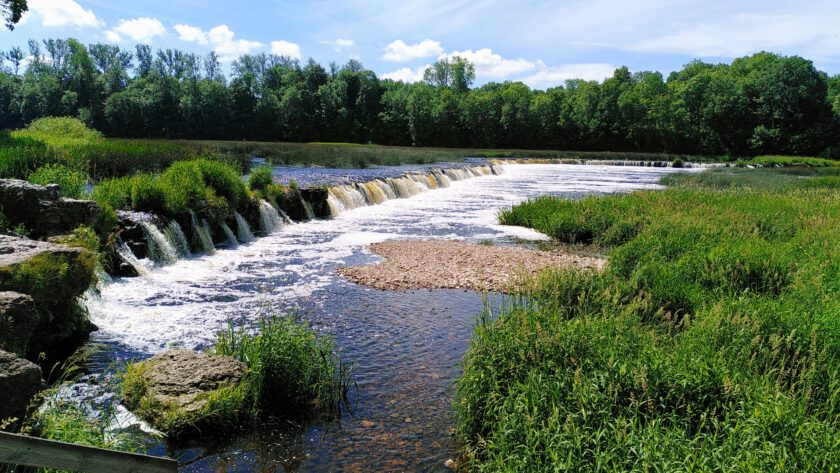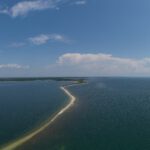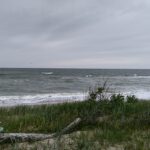Our next stop is Cape Kolka. A headland that separates the Bay of Riga from the Baltic Sea. But first we drive inland to Kuldiga. Kuldiga is a cultural heritage site known for its old wooden houses (World Heritage Site), the longest waterfall in Europe (probably also the lowest) and the longest brick bridge (in Latvia? Europe? The world?). It’s 24 June – today Latvians traditionally celebrate Midsummer. Almost all girls and many women wear flower wreaths, often made of cornflowers. At the entrance to the old town there is a large stand selling bouquets and wreaths. Especially the cornflowers shine from afar. The women at the stand are busily weaving wreaths. The sun is shining, everyone seems cheerful and relaxed. We like Kuldiga. We walk through the old town to the waterfall and the brick bridge. There are a few tourists around, but everything is relaxed and cosy. At lunchtime we find at least a semi-shaded spot on the terrace of Bangert’s – a nice place with a view of the waterfall and bridge. Gaby has cheviche from the local trout and I have a venison burger. Very tasty.
Then we continue towards Cape Kolka. Back on the coast, we look for a campsite for the night. A little north of Ventspils we find one: Kempings Liepene is in the forest with a short path to the endless sandy beach. The owner explains to us in perfect German that it might get a bit noisy at night: The Latvians are celebrating Midsummer. Everyone sits around the campfire and sings and listens to music. And we are welcome to sit there, we just have to collect some wood in the forest and bring it with us. She must have noticed that we are not really party animals and immediately reassures us: „There are mainly families and lots of small children at her place – it will certainly not be loud. Nevertheless, we take the precaution of finding the most secluded corner for our camper. At ten o’clock we fall dead tired into our beds – the landlady is right: we are definitely not party animals. Fortunately, she was probably right with her prediction. We sleep like logs and don’t notice any excesses. They seem to have concentrated more on the beach. The next morning, the beach is littered with quad tracks and the remains of campfires.
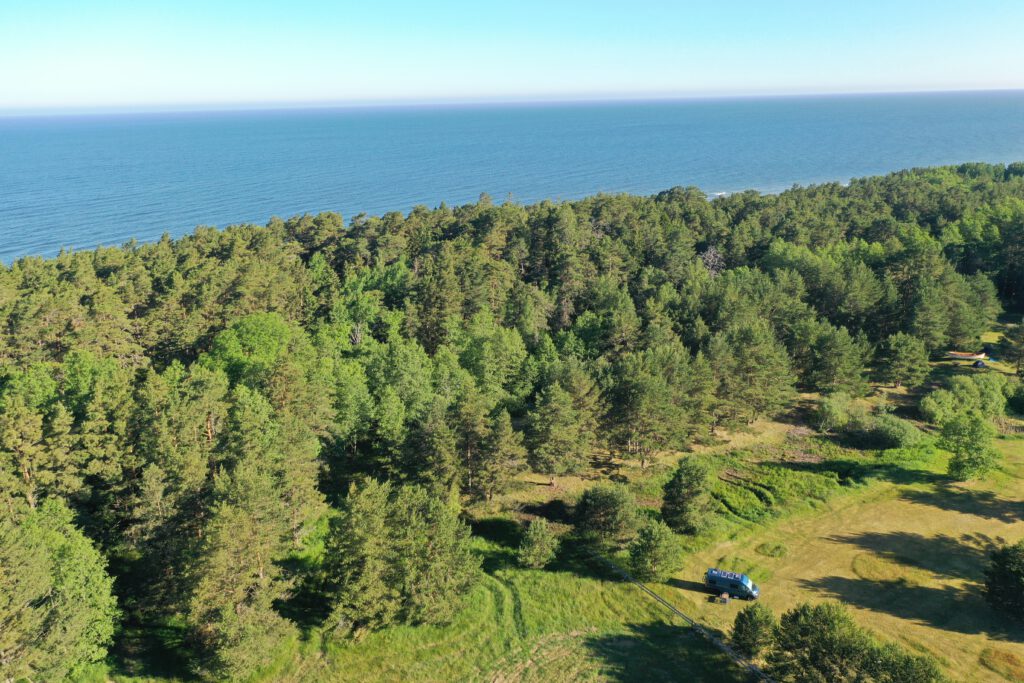
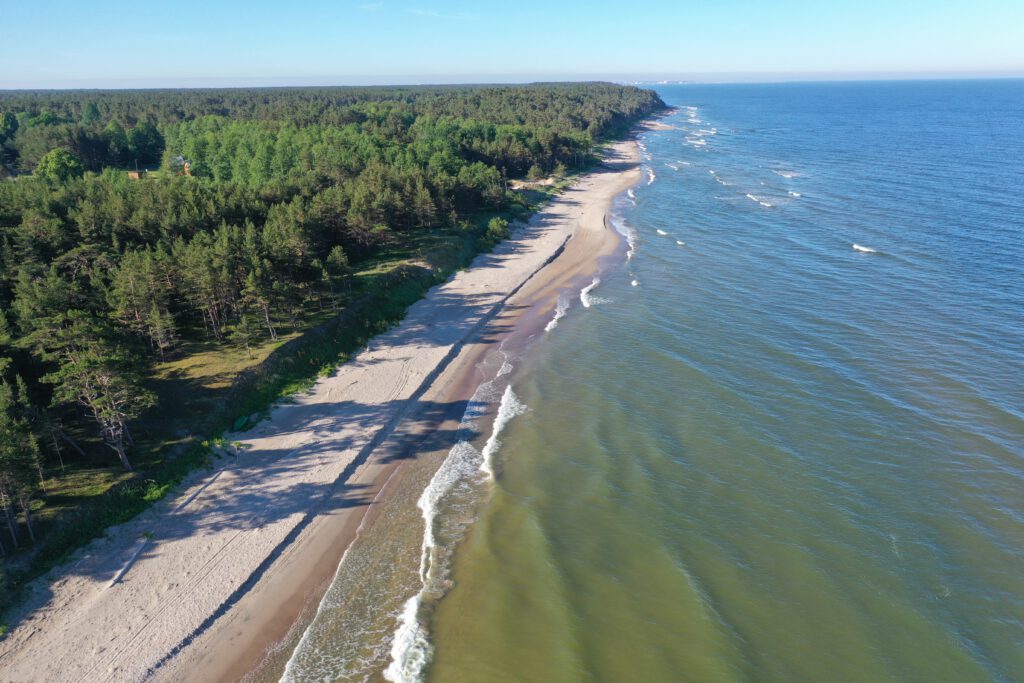
The campsite is beautifully situated, but there are a few little things that spoil the overall picture. For example, there are (simple) showers and toilets, but no washbasins. The emptying and filling of the camper van is also difficult to understand. We drive on to Cape Kolka. On the way we stop again in Mazirpe. There is supposed to be a Livonian museum here. The Livonians are an ethnic group that lives here at Cape Kolka. We don’t find the museum, but a nice little seaside resort with a small supermarket, a beautiful beach and lots of summer resort atmosphere.
There is a lot going on at the paid car park of Cape Kolka – the cape is apparently one of the main attractions here. We first treat ourselves to lunch on the roof of the small café in the middle of the forest. Very nice and not bad at all. Then we walk to the cape, which is actually more exciting than we expected. At the tip of the small headland, small waves from the Bay of Riga meet somewhat larger waves from the Baltic Sea. Somehow quite interesting. The sun is shining, it’s warm, a few people are bathing. Holiday.
Abends fahren wir zurück nach Mazirbe und quartieren uns auf dem dortigen Campingplatz ein. Leider wimmelt es hier von Stechmücken. Wir gehen noch mal zum Strand, baden, und machen noch einen kleinen Spaziergang zum Bootsfriedhof. Hier haben die Sowjets die Fischerboote der Einheimischen zerstört um einer eventuellen Republikflucht vorzubeugen. Litauer, Letten und Esten haben sich nie als echte Sowjetbürger gefühlt. Den Rest des Abends verbringen wir im Camper, die Mücken haben gewonnen.
Am nächsten Tag fahren wir nach Riga. Auf dem Weg dahin legen wir noch einen spontanen Zwischenstopp in Dundaga ein. An einem kleinen See liegt ein altes Deutschherrenschloss. Im späten Mittelalter beherrschte der Deutschherrenorden das Baltikum. Wir machen einen kleinen Spaziergang und lernen noch, dass ein Abenteurer aus Dundaga im letzten Jahrhundert nach Australien auswanderte und dort zum Vorbild für die Figur des Cocodile Dundee wurde. Ein großes Steinkrokodil belegt die Geschichte. Ansonsten wirkt Dundaga mit seiner alten Molkerei und dem Wollgeschäft wie aus der Zeit gefallen.
And we make another stopover: Talsi is said to be one of the most beautiful towns in Latvia. Built on nine hills around two lakes, with many old wooden houses. We take a short walk, but are not really impressed. Maybe it is just too warm already. In Riga we find a car park near the city centre. We walk through parks, along canals and arrive in the picturesque old town. There is quite a bit of tourism here, but still no comparison to what we know from Italy or France. Riga is nice, picturesque parks, beautiful squares, impressive facades. But we are simply not city tourists. We have a very good lunch at the Domini Canes restaurant and walk around the old town for a while. Then we’ve had enough – we go back to the car and drive on towards Estonia. The search for a place to stay is difficult: it is the weekend after the big midsummer party and all the Latvians have gone to the coast for a long weekend of camping and partying. The official campsites are all full to the brim and we hear loud party music. The semi-official sites are just as full and there are also huge piles of rubbish piled up from the days of midsummer partying. Finally we find a parking space at Salacgriva beach. Not our nicest spot, but absolutely fine for one night. We take a short walk to the beach and into the sleepy little town. We spend the rest of the evening in the camper and soon go to bed.
